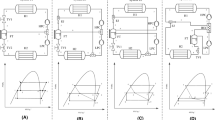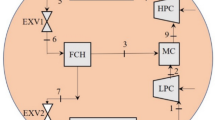Abstract
In the present paper, integration of a two-stage absorption refrigeration system with a compression refrigeration system is proposed for utilizing low-temperature heat and reducing electric energy consumption. The proposed system is analyzed and compared with vapor compression system from the viewpoint of energy, exergy, environment and economics. The proposed system reduces the electricity consumption by 89.3% and CO2 emission from 112.6 to 12.1 ton/year. The size and cost of the system are determined by designing the heat exchangers. The optimization is also performed with the objective of minimizing the annual cost of plant operation which includes fuel exergy cost, initial investment and maintenance cost and environmental damage cost due to CO2 emission. The annual cost of its operation is 21.6% less than equivalent vapor compression refrigeration system which is further reduced by 18.2% through system optimization.













Similar content being viewed by others

Abbreviations
- A :
-
Area (m2)
- \(c_{{{\text{CO}}_{ 2} }}\) :
-
Cost of unit carbon dioxide emission ($/ton)
- \(c_{\text{el}}\) :
-
Cost of unit electricity ($/kWh)
- \(\dot{C}_{\text{env}}\) :
-
Annual environment damage cost ($/year)
- \(\dot{C}_{\text{op}}\) :
-
Annual operational cost ($/year)
- \(\dot{C}_{\text{plant}}\) :
-
Annual cost of plant operation ($/year)
- COP:
-
Coefficient of performance
- CRF:
-
Capital recovery factor
- \(\dot{E}\) :
-
Exergy flow rate (kW)
- \(\dot{\rm ED}\) :
-
Rate of exergy destruction (kW)
- h :
-
Specific enthalpy (kJ/kg)
- HP:
-
High pressure
- HPA:
-
High-pressure absorber
- HPG:
-
High-pressure generator
- HPSTV:
-
High-pressure solution throttle valve
- \(i_{\text{r}}\) :
-
Rate of interest (%)
- LMTD:
-
Log mean temperature difference
- LP:
-
Low pressure
- LPA:
-
Low-pressure absorber
- LPG:
-
Low-pressure generator
- LPSTV:
-
Low-pressure solution throttle valve
- LiBr:
-
Lithium bromide
- \(\dot{m}\) :
-
Mass flow rate (kg/s)
- \(m_{{{\text{CO}}_{2} }}\) :
-
Annual emission of carbon dioxide (ton)
- n :
-
Life span of the refrigeration plant
- p :
-
Pressure (kPa)
- PR:
-
Pressure ratio
- \(\dot{Q}\) :
-
Heat transfer rate (kW)
- ref:
-
Refrigerant
- RTV:
-
Refrigerant throttle valve
- s :
-
Specific entropy (kJ/kg/K)
- SCR:
-
Solution circulation ratio
- STV:
-
Solution throttle valve
- SHE:
-
Solution heat exchanger
- T :
-
Temperature (°C or K)
- \(T_{{{\text{cond}},{\text{VAR}}}}\) :
-
Absorption section condenser temperature (°C)
- \(T_{{{\text{cond}},{\text{VCR}}}}\) :
-
Compression section condenser temperature (°C)
- TSACCR:
-
Two-stage absorption–compression combined refrigeration
- \(t_{\text{op}}\) :
-
Annual hours of plant operation (h)
- VAR:
-
Vapor absorption refrigeration
- VCR:
-
Vapor compression refrigeration
- \(\dot{W}\) :
-
Work transfer rate (kW)
- \(x\) :
-
Concentration of lithium bromide in solution
- \(\dot{Z}_{\text{CI}}\) :
-
Annual levelized capital investment cost ($/year)
- \(\dot{Z}_{{{\text{CI}}\,{\&}\,{\text{OM}}}}\) :
-
Annual levelized capital investment plus operation maintenance cost ($/year)
- \(\dot{Z}_{\text{OM}}\) :
-
Annual levelized operation maintenance cost ($/year)
- \(\epsilon\) :
-
Effectiveness
- η :
-
Efficiency
- η ex :
-
Exergetic efficiency
- λ :
-
Carbon dioxide emission factor (kg/kWh)
- ϕ :
-
Maintenance cost factor
- 0:
-
Represents dead state
- 1, 2, 3…:
-
State points
- cond:
-
Condenser
- cc:
-
Cascade condenser
- comp:
-
Compressor
- el:
-
Electricity
- evap:
-
Evaporator
- gen:
-
Generator
- HPG:
-
High-pressure generator
- HPP:
-
High-pressure pump
- HX:
-
Heat exchanger
- in:
-
Inlet
- LPG:
-
Low-pressure generator
- LPP:
-
Low-pressure pump
- out:
-
Outlet
- p :
-
Pump
- ref:
-
Refrigerant
- SHE:
-
Solution heat exchanger
References
Aminyavari M, Najafi B, Shirazi A, Rinaldi F (2014) Exergetic, economic and environmental (3E) analyses, and multiobjective optimization of a CO2/NH3 cascade refrigeration system. Appl Therm Eng 65:42–50
Arivazhagan S, Murugesan SN, Saravanan R, Renganarayanan S (2005) Simulation studies on R134a–DMAC based half effect absorption cold storage systems. Energy Convers Manag 46:1703–1713
Arivazhagan S, Saravanan R, Renganarayanan S (2006) Experimental studies on HFC based two-stage half effect vapour absorption cooling system. Appl Therm Eng 26:1455–1462
Arora A, Dixit M, Kaushik SC (2016) Computation of optimum parameters of a half effect water–lithium. J Therm Eng 2(2):683–692
Bakhtiar B, Fradette L, Legros R, Paris J (2011) A model for analysis and design of H2O–LiBr absorption heat pumps. Energy Convers Manag 52:1439–1448
Bejan A, Tsatsaronis G, Moran M (1996) Thermal design and optimization. Wiley, New York
Carlsson B, Meir M, Rekstad J, Preib D, Ramschak T (2016) Replacing traditional materials with polymeric materials in solar thermosiphon systems—case study on pros and cons based on a total cost accounting approach. Sol Energy 125:294–306
Cimsit C, Ozturk IT (2012) Analysis of compression–absorption cascade refrigeration cycles. Appl Therm Eng 40:311–317
Cimsit C, Ozturk IT, Kincay O (2015) Thermoeconomic optimization of LiBr–H2O—R134a compression–absorption cascade refrigeration cycle. Appl Therm Eng 76:105–115
Colorado D, Rivera W (2015) Performance comparison between a conventional vapor compression and compression–absorption single-stage and double-stage systems used for refrigeration. Appl Therm Eng 87:273–285
Colorado D, Velazquez VM (2013) Exergy analysis of a compression–absorption cascade system for refrigeration. Int J Energy Res 37:1851–1865
Crepinsek Z, Goricanec D, Krope J (2009) Comparison of the performances of absorption refrigeration cycles. WSEAS Trans Heat Mass Transf 3(4):65–76
Deb K (2012) Optimization for engineering design, 2nd edn. PHI Learning Private Limited, New Delhi
Domínguez-Inzunza LA, Hernández-Magallanes JA, Sandoval-Reyes M, Rivera W (2014) Comparison of the performance of single-effect, half-effect, double effect in series and inverse and triple-effect absorption cooling systems operating with the NH3–LiNo3 mixture. Appl Therm Eng 66:612–620
Florides GA, Kalogirou SA, Tassou SA, Wrobel LC (2003) Design and construction of a LiBr–water absorption machine. Energy Convers Manag 44:2483–2508
Garimella S, Brown AM, Nagavarapu AK (2011) Waste heat driven absorption/vapor-compression cascade refrigeration system for megawatt scale, high-flux, low-temperature cooling. Int J Refrig 34:1776–1785
Garousi Farshi L, Mahmoudi SMS, Rosen MA, Yari M, Amidpour M (2013) Exergoeconomic analysis of double effect absorption refrigeration systems. Energy Convers Manag 65:13–25. doi:10.1016/j.enconman.2012.07.019
Gebreslassie BH, Medrano M, Boer D (2010) Exergy analysis of multi-effect water–LiBr absorption systems: from half to triple effect. Renew Energy 35:1773–1782
Gebreslassie BH, Groll EA, Garimella SV (2012) Multiobjective optimization of sustainable single-effect water/lithium bromide absorption cycle. Renew Energy 46:100–110
Gomri R (2010) Solar energy to drive half-effect absorption cooling system. Int J Therm Environ Eng 1(1):1–8
Herold KE, Radermacher R, Klein SA (1996) Absorption chillers and heat pumps. CRC Press, Boca Raton
Izquierdo M (2004) Crystallization as a limit to develop solar air-cooled LiBr–H2O absorption systems using low-grade heat. Sol Energy Mater Sol Cells 81:205–216. doi:10.1016/j.solmat.2003.11.002
Izquierdo M, Venegas M, García N, Palacios E (2005) Exergetic analysis of a double stage LiBr–H2O thermal compressor cooled by air/water and driven by low grade heat. Energy Convers Manag 46:1029–1042. doi:10.1016/j.enconman.2004.06.016
Jain V, Kachhwaha SS, Sachdeva G (2013) Thermodynamic performance analysis of a vapour compression–absorption cascaded refrigeration system. Energy Convers Manag 75:685–700
Jain V, Sachdeva G, Kachhwaha SS (2015) NLP model based thermoeconomic optimization of vapor compression–absorption cascaded refrigeration system. Energy Convers Manag 93:49–62
Kaushik SC, Arora A (2009) Energy and exergy analysis of single effect and series flow double effect water–lithium bromide absorption refrigeration systems. Int J Refrig 32(6):1247–1258
Kim D, Machielsen C (2002) Evaluation of air-cooled solar absorption cooling systems. In: Proceeding of the 7th international sorption heat pump conference, pp 117–122
Kizilkan O, Sencan A, Kalogirou SA (2007) Thermoeconomic optimization of a LiBr absorption refrigeration system. Chem Eng Process 46:1376–1384
Klein SA, Alvarado F (2005) Engineering equation solver, version 7.441. F Chart Software, Middleton
Medrano M, Bourouis M, Coronas A (2001) Double-lift absorption refrigeration cycles driven by low-temperature heat sources using organic fluid mixtures as working pairs. Appl Energy 68:173–185. doi:10.1016/S0306-2619(00)00048-9
Misra RD, Sahoo PK, Sahoo S, Gupta A (2003) Thermoeconomic optimization of a single effect water/LiBr vapour absorption refrigeration system. Int J Refrig 26:158–169. doi:10.1016/S0140-7007(02)00086-5
Misra RD, Sahoo PK, Sahoo S, Gupta A (2005) Thermoeconomic evaluation and optimization of a double effect H2O/LiBr vapour absorption refrigeration system. Int J Refrig 28(3):331–343
Patel B, Kachhwaha SS, Modi B (2017) Thermodynamic modelling and parametric study of a two stage compression-absorption refrigeration system for ice cream hardening plant. Energy Procedia 109:190–202
Reddy VS, Panwar NL, Kaushik SC (2012) Exergetic analysis of vapour compression refrigeration system with R134a, R143a, R152a, R404A, R407C, R410A, R502 and R507A. Clean Technol Environ Policy 14:47–53
Sayyaadi H, Nejatolahi M (2011) Multi objective optimization of a cooling tower assisted vapour compression refrigeration system. Int J Refrig 34:243–256
Seyfouri Z, Ameri M (2012) Analysis of integrated compression–absorption refrigeration systems powered by a microturbine. Int J Refrig 35:1639–1646
Singh OK, Kaushik SC (2013) Thermoeconomic evaluation and optimization of a Brayton–Rankine–Kalina combined triple power cycle. Energy Convers Manag 71:32–42. doi:10.1016/j.enconman.2013.03.017
Wang L, Ma A, Tan Y, Cui X, Cui H (2012) Study on solar assisted cascade refrigeration system. Energy Proc 16:1503–1509
Zare V, Mahmoudi SMS, Yari M, Amidpour M (2012) Thermoeconomic analysis and optimization of an ammonia–water power/cooling cogeneration cycle. Energy 47:271–283
Author information
Authors and Affiliations
Corresponding author
Rights and permissions
About this article
Cite this article
Dixit, M., Arora, A. & Kaushik, S.C. Energy, exergy, environment and economic analyses and optimization of two-stage absorption–compression combined refrigeration system. Clean Techn Environ Policy 19, 2215–2229 (2017). https://doi.org/10.1007/s10098-017-1404-3
Received:
Accepted:
Published:
Issue Date:
DOI: https://doi.org/10.1007/s10098-017-1404-3



